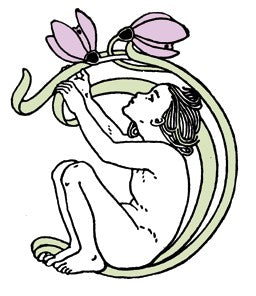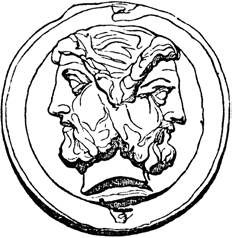You have no items in your shopping cart.
Almanac Holidays
A year is punctuated by annual holidays, holy days, festivals and celebrations. Every year, beginning with our 94/95 issue, The Witches’ Almanac has featured a list of annual holidays, which may be found among its front pages as well as within each issue’s Moon calendar pages. These dates were compiled by Elizabeth Pepper, the founder of The Witches’ Almanac.
Many of these dates, such as the Equinoxes, Solstices and Sabbats are widely familiar but others like the Night of the Watchers, White Lotus Day and the Feast of Janus remain mysterious and elusive. Because of this, every year, The Witches’ Almanac receives mail from readers seeking information about these holidays. In response to these many requests, long-time Witches’ Almanac staff writer, the late Barbara Stacy, compiled the following introductions and explanations.
Many of these dates, such as the Equinoxes, Solstices and Sabbats are widely familiar but others like the Night of the Watchers, White Lotus Day and the Feast of Janus remain mysterious and elusive. Because of this, every year, The Witches’ Almanac receives mail from readers seeking information about these holidays. In response to these many requests, long-time Witches’ Almanac staff writer, the late Barbara Stacy, compiled the following introductions and explanations.

March 20, Vernal Equinox
Ostara, Gwyl Canol Gwenwynol
The first of the four great solar festivals. Spring ushers in the New Year when the Sun enters Aries, the first sign of the zodiac. At the Equinox, night and day are of equal twelve-hour length. Ancients aware of the phenomenon marked the astrological occasions with a cluster of megalithic cairns world- wide. The Saxon dawn Goddess Eostre, from whom we derive the term Easter, is the divinity of the new day. Ancient Gods and Goddesses, from Astarte to Attis, from Isis to Demeter, symbolize the Eternal Return of the seasons. It is a time to renew aspirations and renew relationships, as well as an auspicious time to begin new projects. At the Vernal Equinox, celebrants light candles and delight in dancing, singing and feasting. A sacramental bonfire is lit and Witches leap over the embers to encourage human and crop fertility. Eggs and seeds — symbols of new animal life and new plant life — hold traditional places in the festival, and hares dwindle into bunnies in baskets. Children share the fun of painting eggs. City dwellers echo ancient farm rituals by planting pots of seeds or bulbs, blessing them, visualizing their growth and the wisdom we want to grow in our own lives.
April 1, All Fools’ Day
April Fool, ha ha ha. The lighthearted holiday has been amusing people since antiquity — the giddiness of spring fever seems timeless. One basic game, of course, is sending some trusting soul, “a fish,” on a “fool’s errand.” In France the dupe is known as poisson d’avril; in Italy, pesce d’aprile. The Scots observe the date as “Gowk Day” and send the “gowk,” or fool, off with a sealed letter. The message reads, “Dinna laugh, dinna smile, send the gowk another mile.” And they do, they do. The Jews enjoy traditional spring playfulness at Purim. But the oldest laughter tradition may be Sizdah Bedar, celebrated by Persians as far back as 536 B.C.E
April 30, Beltane Eve
Shining Fire, Nos Calan Mai
Classic May Day consecrates love and fertility with the ancient rites of spring. On the eve of Beltane the Druids built fires on hilltops across Britain as acts of magic, coaxing the Sun back to summer splendor. To jump between two Beltane bonfires brought good fortune in the form of prosperity and health to livestock. Girls jumped over the embers to secure husbands and safe pregnancies, ashes to be flung on crops. Maypoles were erected, survivors of the oldest religious rites in the West. Dancing and singing around maypoles, phallic symbols meant to impregnate the earth, were enjoyed, followed by nightlong feasting and lovemaking. A Queen of May and King of May reigned over the erotic festivities. 
May 8, White Lotus Day
Theosophists marked the passing of Madam Helena Blavatsky on May 8 according to her will — by a reading from the Bhagavad Gita. On that date one year later, devotees observed that lotuses grew in unusual profusion. The Society venerates its founder annually on the memorial date with rites centering around the symbolic flower. The root of the lotus sunk in mud represents material life, the stalk passing through water represents the astral world, and the glorious floating blossom opening to the sky represents spiritual beings.
May 29, Oak Apple Day
In 1660 following the Battle of Worcester, King Charles II was fleeing for his life. Evading Cromwell’s soldiers, he took refuge at Boscobel Castle in a lofty oak, perfect for camouflage. His hosts cut his fashionably long hair, dressed him in rough clothes and propelled him upward. There he stayed for the day, fortified by bread, cheese and beer. The ruse saved the king’s life, and to this day a descendant of that tree is honored as the Royal Oak, the familiar name of many an English pub. King Charles escaped and Parliament declared May 29 Oak Apple Day. The “apple” refers to a reddish gall resembling the fruit, formed by larvae of hornets.
May 9, 11, 13, Lemuria
A sunken Pacific continent sometimes designated as Mu. Dates for the Lemurian timeline vary, but some put it at millions of years ago, prior to Atlantis. Others speculate that Lemuria and Atlantis co-existed for thousands of years. Legends also vary. The prime belief advances a culture that manifested out of nowhere, and its downfall resulted from a natural disaster aroused by human imbalance. In The Secret Doctrine, Blavatsky writes about powerful “dragon men” on Lemuria whose rampant black magic doomed the culture and sank the continent. Explorer James Churchward popularized the Lost Continent of Mu in a notable five-book series.
June,* Vesak Day
Buddha Celebration, Triple Gem
Falling on the full Moon of the 5th or 6th lunar month, Vesak Day lauds the birth, enlightenment and passing away of Buddha. Followers worldwide assemble at dawn in temples for rituals, singing hymns in praise of the Triple Gem — the Buddha, his dharma (teaching) and his sangha (disciples). Devotees bring traditional gifts to teachers — incense, flowers, candles. Some countries mark the occasion for two days, during which time celebrants eat only vegetarian food. In Sri Lanka all slaughterhouses and liquor shops close. Birds and animals are ritually released from captivity by the thousands in an “act of liberation,” symbolic of giving freedom to people suffering in captivity. Often devout Buddhists wear white and spend the whole day in temples, renewing their resolve to abide by the Ten Precepts. Some sanctuaries provide an altar with a basin of water and flowers holding an icon of the baby Buddha. Celebrants pour water over the statue, evocative of devas and spirits making offerings at the birth fraught with heavenly significance. *Date changes with lunar month
June 20, Midsummer’s Eve
Midsummer Day, Litha, Gwyl Canol Haf
Magic magnified. All that is mystical has particular potency during these hours, as for the other two “spirit nights” — May Eve and Samhain. In A Midsummer Night’s Dream, Shakespeare evokes familiar Pagan enchantments — a plant arousing love, fairies, transformations, magical flight. Puck can “put a girdle round the world in forty minutes.” Above all, impish spirits cause disorder, for “bright dreams come to confusion.” Throughout Europe, Britain and especially Scandinavia, drunkenness was not discouraged nor was lovemaking, June bringing little farm work and a good time for birthing babies. Bonfires flickered on hills — neglect to light one at your peril, for your house might be set afire by mischievous spirits. Herbs gathered during this time are especially effective for medicinal purposes. Other plants are treasured for their use in charms and divination, including elderberries, yarrow and vervain. St. John’s wort hangs above doors to avert entrance of evil. During the night hazel branches, cut between midnight and one o’clock, were used to find water, gold or gems. Fern seeds were also considered invaluable on Midsummer Eve for help in eluding fairies “ill met by Moonlight.” And then “Night’s swift dragons cut the night full fast/ And yonder shines Aurora’s harbinger/ At whose approach ghosts, wandering here and there/ Troop home to churchyards.”
June 21, Summer Solstice
Midsummer Day, Litha, Gwyl Canol Haf
A fertility festival to lift hearts! On the longest day of the year bonfires are lit on hillsides and celebrants leap over them for luck. Parents carry their children over the coals, the little ones blessed and cleansed by the smoke. Cattle are driven over the ashes to ensure their health and the ashes are scattered over crops for a rich harvest. Farmers light torches from the fires and carry them around the fields, reflecting the Pagan belief that fire symbolizes the Sun’s rays. In some areas of Britain “Sun wheels” made of hay were rolled down hillsides to imitate the Sun. The Solstice is ritually marked at high noon, when celebrants pause in a sunny place to absorb the rays and establish a connection with solar energy. The rites convey a time for purifying, for cutting through barriers, for drawing upon one’s spiritual powers. On this day ancient rituals by Druid priests resonate at Stonehenge and other megaliths scattered around the world. Contemporary Pagans gather particularly at the Salisbury Plain to watch the Sun rise over the Heelstone and connect with their archaic ancestors. The Celts believed that the Oak King, a God of light, is at the height of his powers and reigns over the longest day. From the solstice he gives way to his twin brother, the Holly King, a divinity of darkness — “longer-nights darkness” rather than evil. Traditional decorations for Midsummer Day include fir boughs, birch branches, fennel, and lilies. And of course the most cheerful denizens of the garden, sunflowers.
July 23, Ancient Egyptian New Year
Opet
Egyptian culture flows in harmony with the Nile, reflected in the pageantry of the most important ancient holiday. Early astrologers adapted a series of calendars, but always the New Year coincided with Achet, the flooding of the Nile Delta. The annual date links to bright Sirius, arising just before sunrise at this season. Until waters receded, farmers had respite from work and time to celebrate. The festival chiefly honored Amon, God of Gods, holiness incarnate. His icon journeyed by boat from the temple at Karnak to Luxor, followed by the pharaonic barge and the royal family. Amon continued at Luxor for twenty-four days and then ceremonially returned to his main temple. Isis was also lauded, for the ancients believed that her tears for the murdered Osiris caused the enriching flood. And since Sirius was a shining manifestation of Mother Goddesses, Hathor and others were similarly honored. The light of this day from feminine Sirius united with the masculine Sun, and statues were removed from temples to bathe out-doors in the total sacred forces of light.
July 31, Lughnassad Eve
Celtic First Harvest, August Feast
The Mother Goddess gives birth to grains as the Sun God’s strength wanes and days become shorter. Bread is baked, crumbled and thrown into sacrificial fire. The Celtic festival derives its name from the Irish God Lugh. The celebration was dedicated to his foster mother, Queen Tailtiu, who died from exhaustion after clearing a huge forest for farmland. According to her death- bed promise, if the men of Ireland held annual games in her honor the country would never be without song. Lughnassad evolved into a huge rowdy fair, tribal assembly, music and sporting event in County Meath dominated by the High King. “Handfasting” was a feature, a system of random trial marriages to last a year and a day. Celebrants danced giddy jigs and reels to fiddles and flutes. Sometimes a female effigy was placed on a throne strewn with garlands. Riotous dancers whirled around the figure, honoring the Goddess and pulling off flowers or ribbons for good luck.
August 1, Lammas
Loaf Mass Day, Feast of First Fruits, Nos Gwyl Awst
The Anglo-Saxon festival celebrating the first wheat crop of the year. Tenants in medieval England brought their lords an agreed share as rental “first fruits.” On this day villagers brought to church their own loaves of bread to be blessed as the “new fruits.” Lammas offers the opportunity for some harmonious sacraments at home. As you make wheat bread, remember that the flour derives from something live. If you have a garden add some- thing of your own — onion, herb, seeds. Traditionally the bread is formed into male or female figures to be presented to opposite genders. Or you may make cornbread, gingerbread or popcorn. All that matters in entering a sacred zone is intention and awareness. Sharing bread at a holiday feast, traditionally guests feed each other chunks as they say, “May you always be nourished.” And there are many ways to be nourished.
August 13, Diana’s Day
All Rome turned out to honor the beloved Goddess Diana. The most democrat of deities, her temple stood in the working-class section of the city. In the countryside any grove — pine, cedar, laurel, willow — served as a place of worship for this rustic Goddess. Counterpart of the Greek deity Artemis, Diana lingered in any dappled place. The duo are divinities of the Moon and the hunt, celestial and sublime, patronesses of women in childbirth, guardians of youth, comforters of the oppressed, healers, protectors of wildlife. On Diana’s Day pampered patricians served themselves, for servants and slaves were allowed a carefree celebration. To reflect the ancient occasion, decorate your home with greenery and hang a tree with symbols of the Goddess — crescent Moons, bows and arrows, silver masks, tiny animal figures. Traditional feasting fare includes meat roasted on spits, apples still hanging from boughs and bowls of cider.
August—September*
Ganesh Festival
Known as the remover of obstacles, the beloved elephant-headed God, son of Shiva and Parvati, is the supreme deity of wisdom, prosperity and good fortune. His bulging belly is said to contain the essence of the cosmos. Ganesh is honored at Chaturthi for ten days featuring feasts, dancing, singing, poetry and dramas, finishing with a huge public festival on the eleventh day. Rites center around icons of all kinds, from 3/4-inch clay images to those over 25 feet tall for procession floats. Red is the prevailing color and in temples priests clad in red silk invoke blessings from the garlanded idol, followed by the “sixteen ways of paying tribute.” At the mega-event Ganesh is carried through the streets to river or sea. The immersion of the God symbolizes the washing away of misfortunes. A variety of community benefits also are traditionally offered — free medical checkups, blood donations, charity. To honor the occasion at home, set up a puja table with a Ganesh image of any kind. Decorate it with red flowers, sandalwood paste, camphor, coconut sweets or what you will. Meditate on the deity and invoke his aid for spiritual strength in your undertakings. You may conclude with the traditional appeal, “O Father Ganesh, come again early next year.”*Date changes with lunar month

September 22, Autumnal Equinox
Harvest Home, Wine Harvest, Gwyl Canol Hydref
Once again day and night are the same length. The name derives from a myth about Mabon, son of Modron, a Pagan Earth Mother. The second and most important of the harvest festivals and the end of the year’s farm labor, the “Witches’ Thanksgiving.” The corn spirit hovers over the celebration. The last stalks were ritually cut, tied into human forms, sometimes dressed and variously called corn dollies, corn maidens, corn mothers, kern babies. Celebrants sometimes honored ripeness by considering the images crones, Old Hags and Old Wives. The veggie icons proceeded in procession back to farmhouses, where they hung above hearths to induce prosperity. A few months later, at first plowing, the corn dolly was buried in the first furrow to encourage a rich summer harvest. Ancient Celts sometimes manifested the reigning spirit as male, Corn King or Harvest Lord. In this guise they con- ducted a fiery mock sacrifice of a large wickerwork figure, inspiration for two chilling films. Mabon is the occasion for feasting; for drinking wine, ale, or cider; for rejoicing in the fruits of the earth; for sharing with the homeless. For giving thanks to the divine forces that nourish life on earth.
October 31, Samhain Eve
Hallows, Ancestor’s Night, Halloween, Nos Calan Gaeaf
For some witches, Samhain (pronounced SOW-en) marks the beginning of the new yearly cycle as well as the last day of the Sabbat cycle. The holiday ushers in the dark winter half of the year and its third and final harvest. Bonfires flickered throughout the Pagan world at Samhain, the time to prepare grain and meat for winter survival. Farmers cast the remains of slaughtered cattle on the “bonefire” and ritually lit their hearths with torches from the flames, bonding families into a virtual village. Celts celebrated in costumes, often of saints, angels and devils. It is the remote precursor of Halloween and the ultimate time to honor loved ones who have passed on — ancestors, mentors, friends, pets. It is easiest to reach across the veil during this interlude of Dark Mysteries. For Witches it provides a potent interval for communicating with the dead and pursuing magic — divination of any kind, transformation spells, visions waiting to be evoked. Food specialties of the departed turn up at feasts and may be accompanied by favorite songs, dances and poetry of the deceased. Celebrants place a candle in a western window or leave it open to encourage visitations from the “wandering dead.”
November 1, Hallowmas
All Saint’s Day
When the Romans engulfed the Celts in the first century, the conquerors added two festivals to Samhain: honor to Pomona, Goddess of fruit and trees, and Feralia a day to honor the dead. If you have ever bobbed for apples at Halloween, you have been paying tribute to Pomona. But when Christianity had overtaken the old Pagan territories, the Church issued its own autumnal calendar. In earlier days faithful Christians were obligated by the clergy to celebrate individual saintly anniversaries. But during Roman persecutions the roster of martyrs grew to such length that it was impossible to assign a celebration for each. In the eighth century the Church established All Saints’ Day, ensuring that each saint and martyr, known and unknown, received veneration in general ritual. The following day was decreed All Souls’ Day, the time to honor the dead. It was celebrated similarly to Samhain with bonfires, costumes, food set out for the dead and graveside ceremonials.
November 16, Hecate Night
In ancient Greece Hecate is the daughter of a Titan and endowed with dominion over sky, sea and land “She who works her will” can bestow blessings or evil as she chooses. In other times and places Hecate morphed into an attendant at child- birth and deathbeds, a Moon Goddess and a huntress, “the Far Shooting.” She strides underground to guide Persephone in Hades. But in the neoclassical era the deity emerges as our familiar Queen of Ghosts, revered patroness of witchcraft. She savors of magic, with power to conjure up dreams, fantasies and prophecies. Hecate is associated with certain plants, poisons and hallucinogens, including belladonna, mandrake, aconite and hemlock. Some- times Hecate is depicted as a single figure in a black robe. But more often she turns up as Trivia, the triple Goddess guarding crossroads literal and allegorical. Facing in three directions she sees the past, present and future. In some portrayals she has three beautiful faces, in others three fierce animal heads — snake, bear, horse. Always the Queen of Ghosts is associated with hounds, and howling is the first sign of her approach. She commonly travels with ghosts and mortals who live on the edge. Some adherents avoid such a shadowy entourage by placing food on doorsteps to placate spirits and perhaps feed the outcasts. Triple masks and other offerings are hung at the crossroads in Y- intersections where three roads converge, offered by seekers who wish guidance for “the right direction.”
December 17, Saturnalia
Farmers have finished autumn planting and it is time to eat, drink and be merry, if not hysterical. Little wonder that the Saturnalia is the favorite Roman holiday, later celebrated for one whole week. Libanius, a fourth-century writer, gives a glimpse of the urbane celebration: “There is food everywhere, heavy, rich food. And laughter. A positive urge to spend seizes everyone. The streets are full of people staggering under the load of gifts.” Sound familiar? Traditional gifts ranged from cheap-and-cheerful to luxurious: small earthenware cult figures, dice, combs, perfume, axes, parrots, sausages, masks. Saturn, the honoree, had a dual nature. He was identified with the Titan Cronos. His reign was considered a Golden Age, and the Saturnalia was meant to re-create the felicity. Battles were forbidden, businesses closed, the executioner hung up his axe. Slaves could gamble, feast with their masters and wear their clothes. But long after the time Cronos had evolved into Saturn, the deity had lapsed into the sardonic character of astrology. A joyous holiday! A fearsome God! History is rich in irony.
December 21, Winter Solstice
Yule, Yuletide, Midwinter’s Day, Gwyl Canol Gaeaf
As early darkness closed in, early Pagans feared they would never again see the golden face of the Sun. The Sun God, they believed, had vanished into the Underworld to learn the secrets of life and death. The Winter Solstice was a time for magic, for pleading with the Mother Goddess to restore the deity needed to warm the Earth. The same cherished rituals have been observed down the ages, many derived from the cold climates of northern Europe. Mistletoe was honored because it grew mysteriously on the sacred oak. Other than mistletoe, too associated with Pagans, the Church adapted many earlier elements into the celebration of Christmas. The decorated trees, Yule logs, holly, wreaths, ham on the festive table, wassail — all resonate significantly from a dim past. Traditionally the time favors divination and prophecy. At the festive table ancient Romans created Bowls of Fate with family names on slips of paper. Names were drawn in pairs and the two become special friends. Scandinavians may place all their shoes together to ensure a year of family harmony. In Russia a young woman sits with candles and mirrors placed to reflect the image of her future husband. Whatever your observance, usher in the Winter Solstice as a marvelous interval for introspection and planning the future.
January 9, Feast of Janus
The first month of the modern calendar receives the protection of Janus, God of beginnings, developed from his supervision of entrances. On this date the high priest’s residence in the Forum was the site of the annual state sacrifice to Janus — an offering of ram. Romans believed the deity’s spirit hovered in all doorways, gates and passageways. Since entrances also serve as exits, and since good beginnings imply good endings, Janus is depicted bifrons — with two faces, hand- some and bearded, for viewing forward and backward simultaneously. Janus worship first existed as an agrarian cult, later introduced to Rome by the legendary Romulus. The populace invoked Janus before any other God at any new undertaking. Romans especially sought his patronage for peace after war, purification of youths on the threshold of manhood, and good luck in sowing the new crop.
February 1, Oimelc Eve
Imbolc, The Feast of Brighid
Deep Gaelic roots marked the festival improbably honoring ewe’s milk. But it was the time of year when herd animals bear their first offspring and life flows in lactation. Ancient ceremonies honored growth and renewal; seeds and farm tools were blessed. The Goddess Brighid, Exalted One, Light Bringer, presided over the holiday. She taught early mortals the mastery of brewing, dying and weaving, as well as poetry. Since poetry resonates with the magic of seers, Brighid inspired divination and prophecy, a source for oracles. The lovely Goddess carried a white wand and breathed new life into the deadness of winter, awakening the smiles that shine on warmer days. Brighid’s snake emerged from the womb of the Earth Mother to test the weather, forerunner of modern Groundhog Day. Candles and sometimes bonfires greeted the festival, as well as besoms, acorn-tipped wands, corn dollies, irises, violets and all white flowers. Traditional gems for bracelets and other adornments include turquoises, amethysts, garnets. As for the food, it seems appropriate to set up a fresh, simple farm meal. Dairy drinks and dishes are traditional, as are spring- garden vegetables and offerings with seeds — poppyseed rolls, whole-grain breads, pumpkin seeds and sunflower seeds for munchies. Follow with spiced wine and herbal tea.
February 2, Candlemas
Nos Gwyl Fai
Today’s ritual has remote ancestry in Lupercales, a rowdy Roman celebration of an ancient pastoral deity, in which crowds ran wild through the streets waving flaming torches. In 472 Pope Gelasius I Christianized and tamed the old Pagan festival, retaining the metaphor of Light. He termed it the Presentation of the Child Jesus in the Temple, commemorating the Virgin Mary’s presentation of her newborn Son to God, formerly known as the Purification of the Blessed Virgin Mary. Since Pope Gelasius was notable in Rome for providing pancakes to weary pilgrims, pan- cakes turn up at Candlemas festivals. The delicious golden disks also remind us of the Sun and ideally these should be made with wheat from the previous year’s harvest. Family and friends can eat their fill without fear of famine, for soon the fields will turn golden with the new crop. A gold coin will help Nature along. According to tradition, hold a gold coin in your left hand and flip the first pancake in the skillet with your right. If the pancake lands nicely on its return trip to the pan, you will enjoy happiness and money during the year to come. In the American tradition, early Pennsylvania German settlers consider the date Groundhog Day, using the sleepy little animal to forecast weather.
March 1, Matronalia
Marriage and childbirth were on the minds of celebrants. All honors go to glorious Juno, wife of Jupiter and Roman Queen of the Gods. At the Matronalia men swore their undying love for spouses and sweethearts. Couples celebrated at Juno’s great temple in Rome with offerings of fruit and flowery wreaths, praying for happiness in their unions. Lambs and cattle lost their lives at sacrificial altars. Feasting and rejoicing followed, and on this day mistresses served their female slaves. At the Matronalia the deity was notable in her role as Juno Lucina, Goddess of light. The “light” referred to childbirth, when a baby is first “brought to light.” On this holiday Roman wives, usually the height of elegance, dressed down for the occasion. They undid their belts, loosened any knots in their robes, and unbraided their usually intricate hair styles. The calculated carelessness encouraged Juno Lucina to loosen their wombs and help babies emerge from the darkness.

